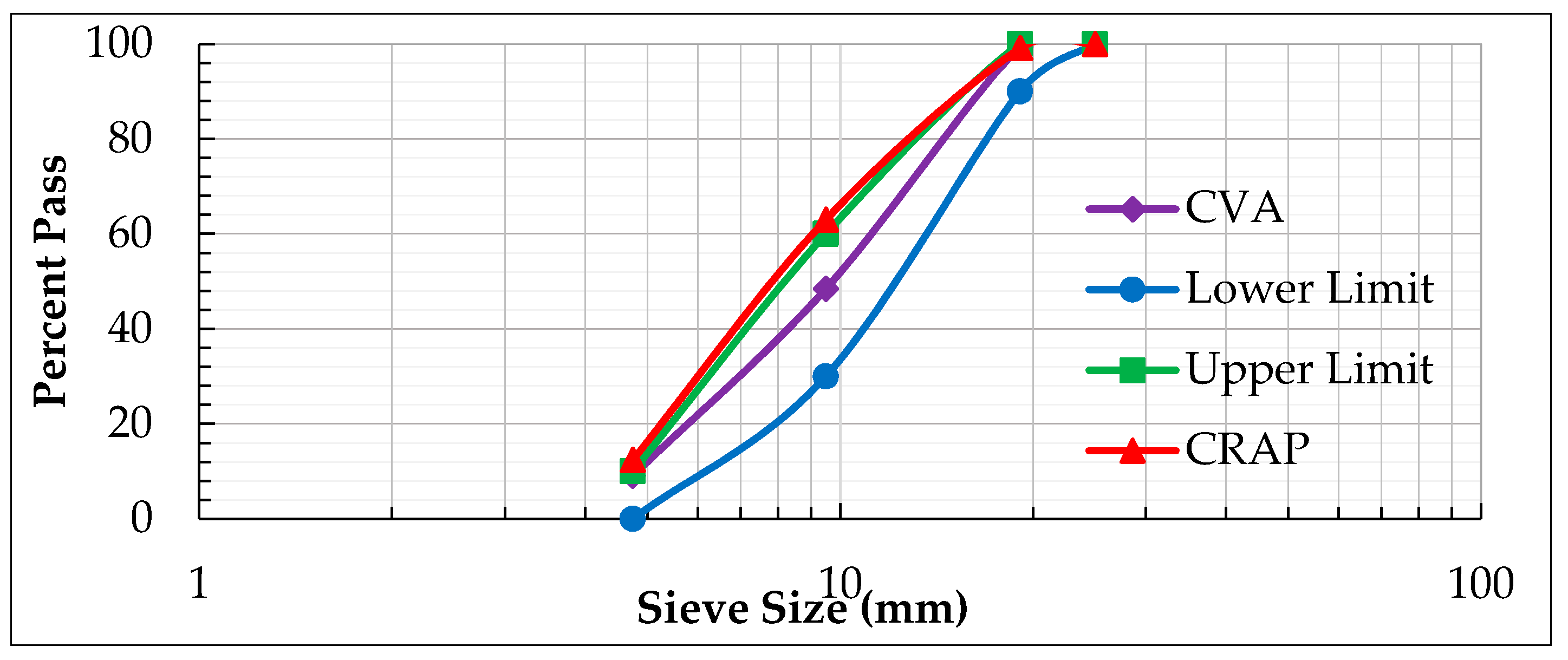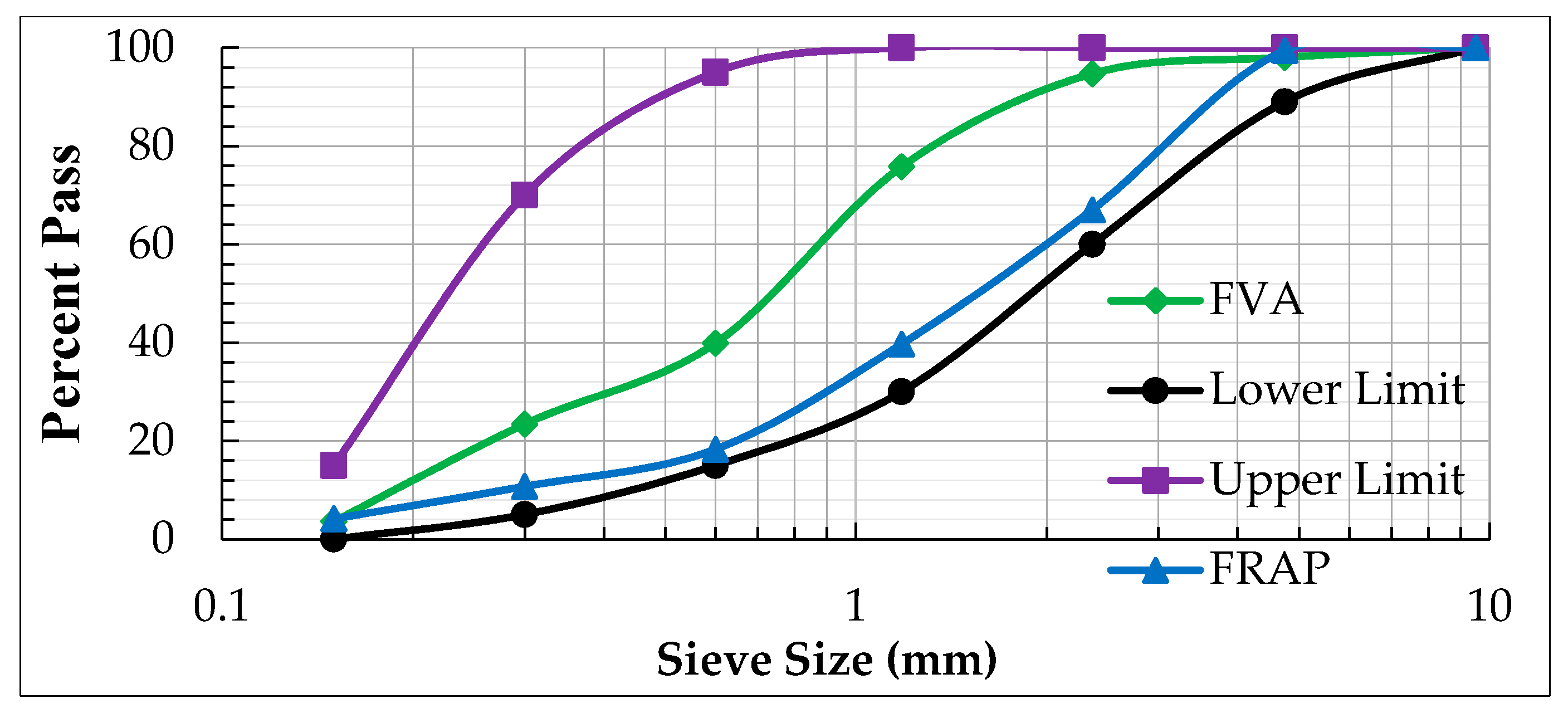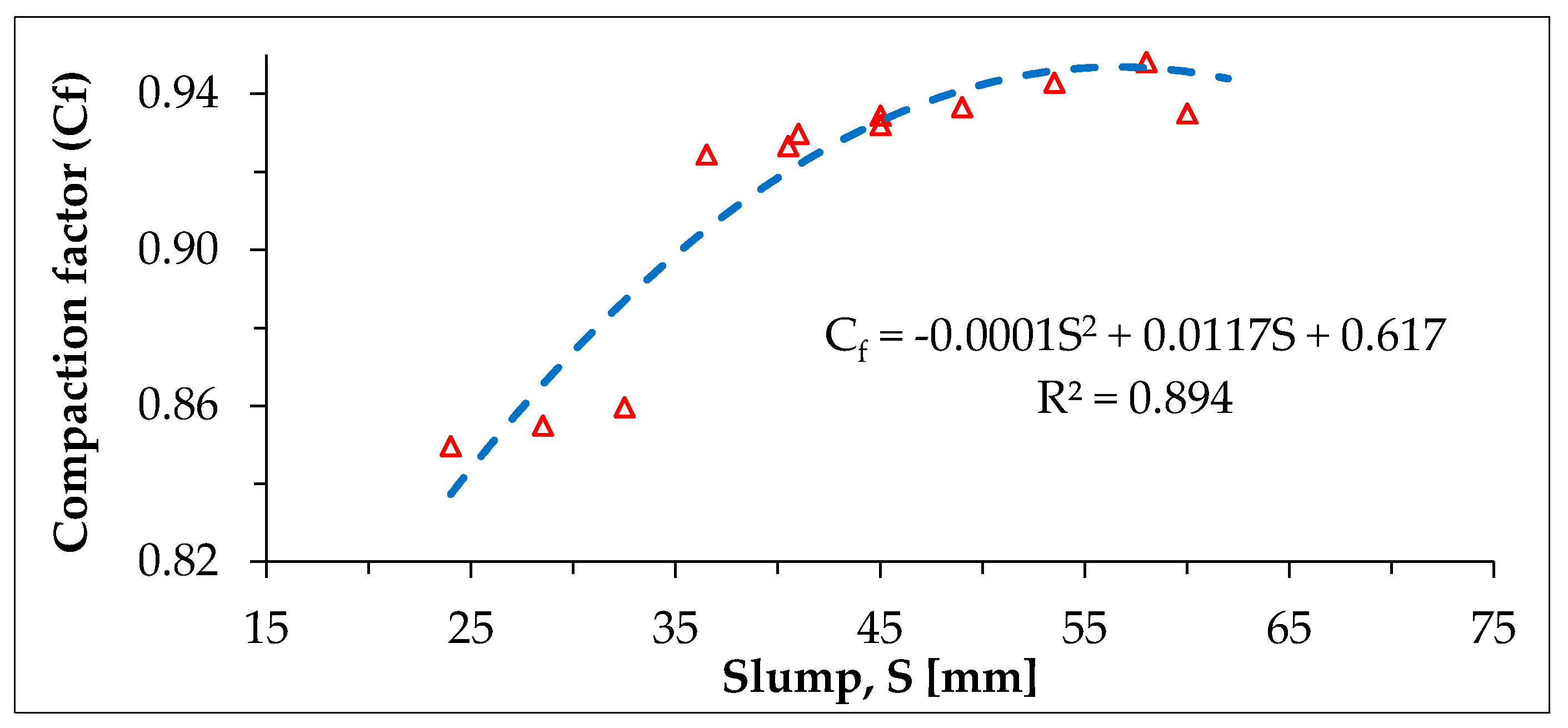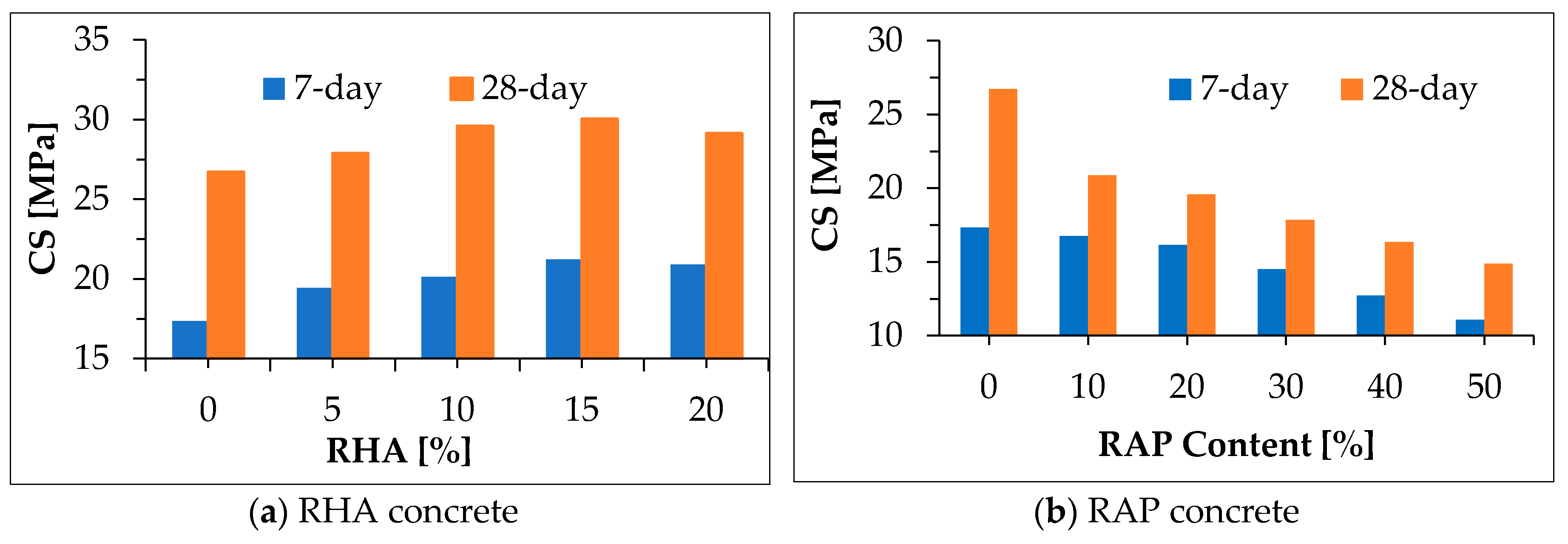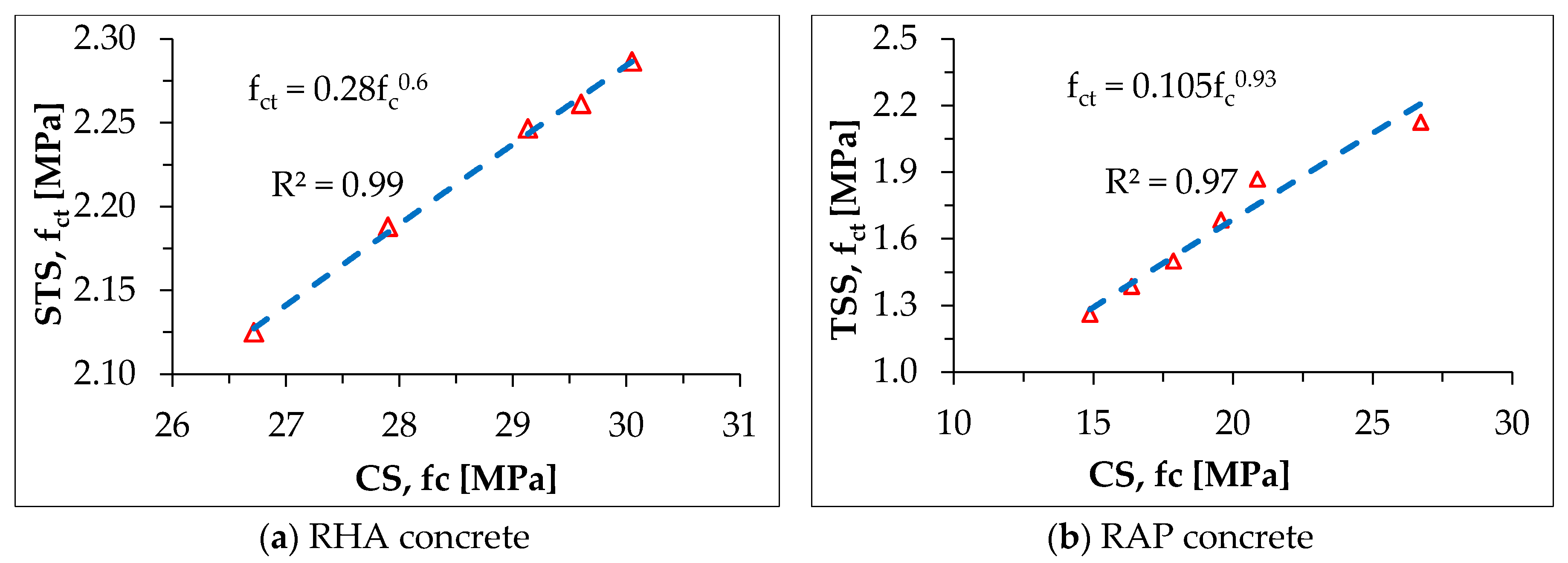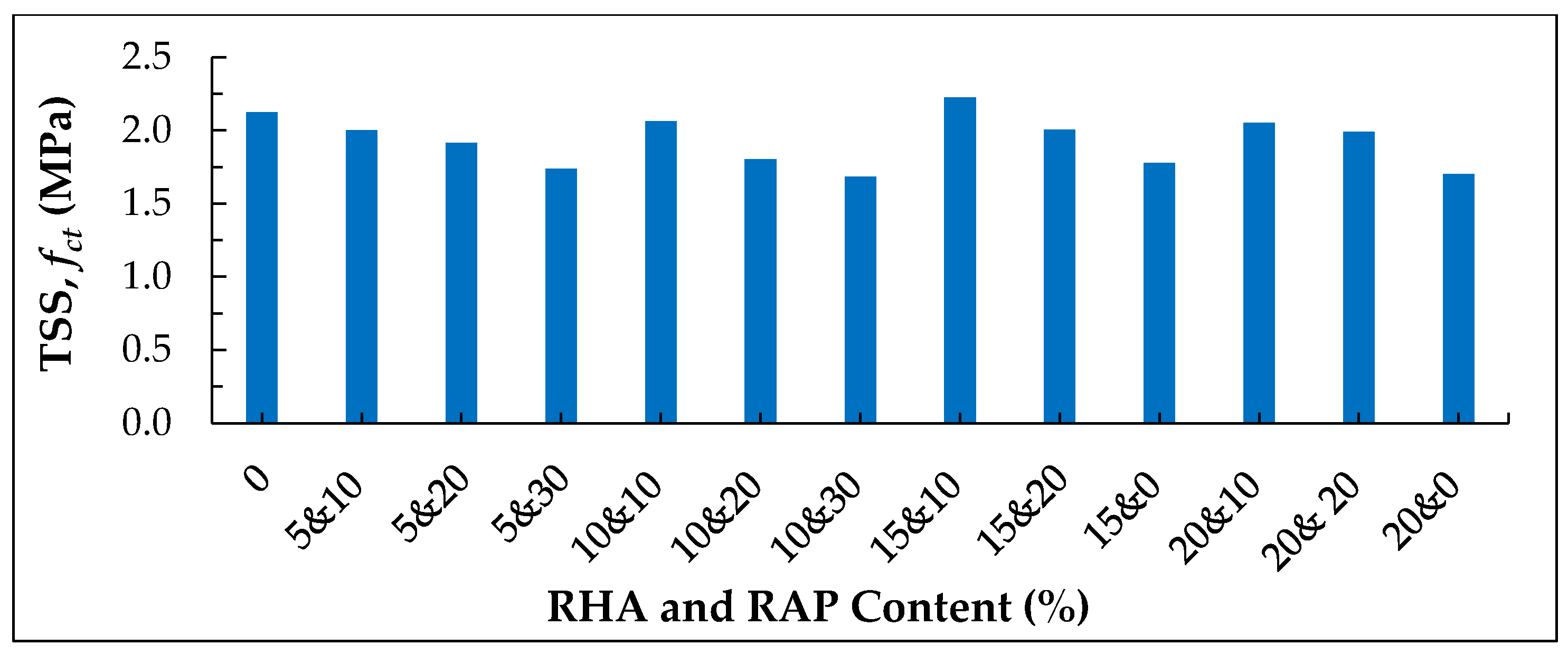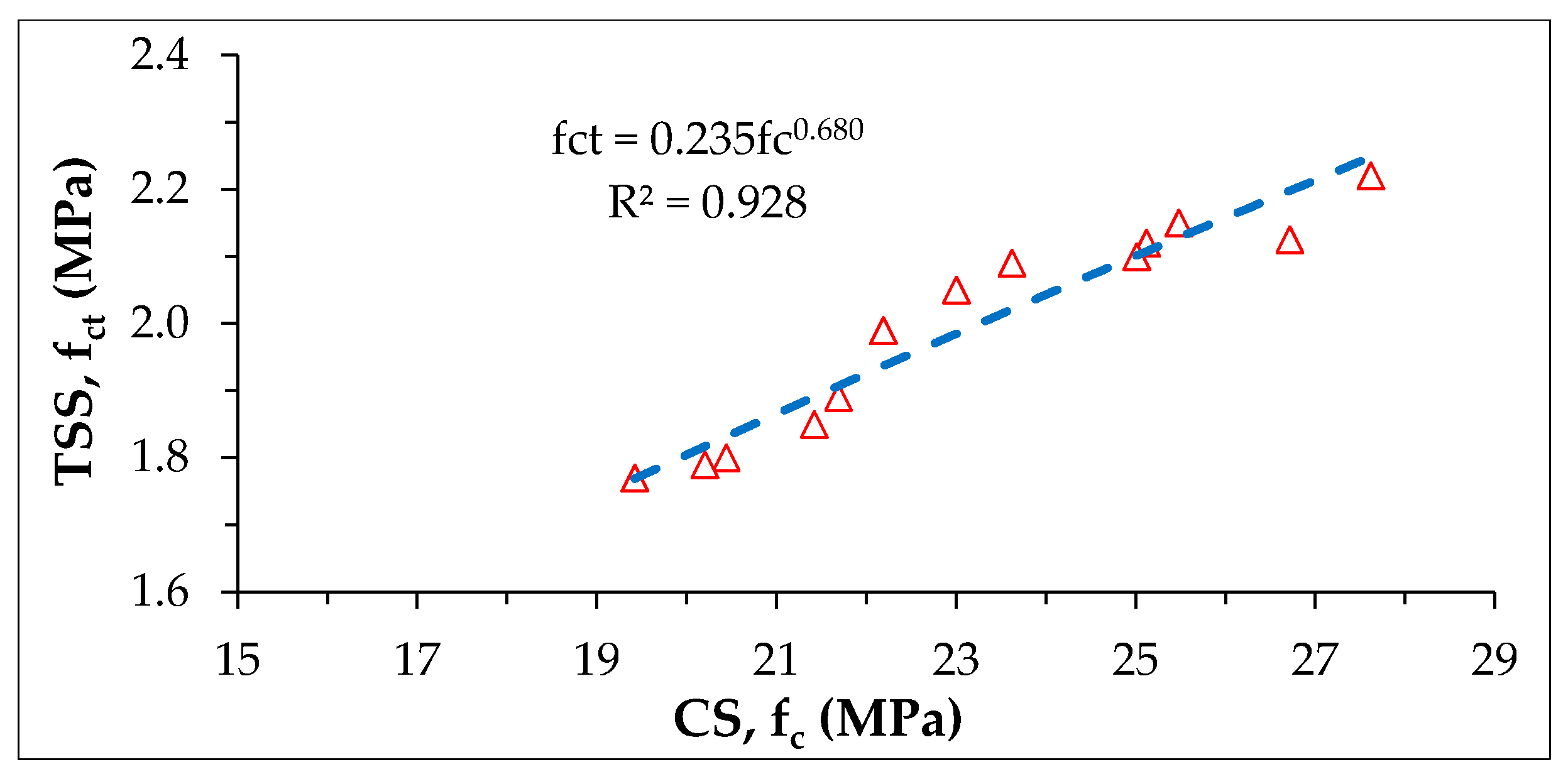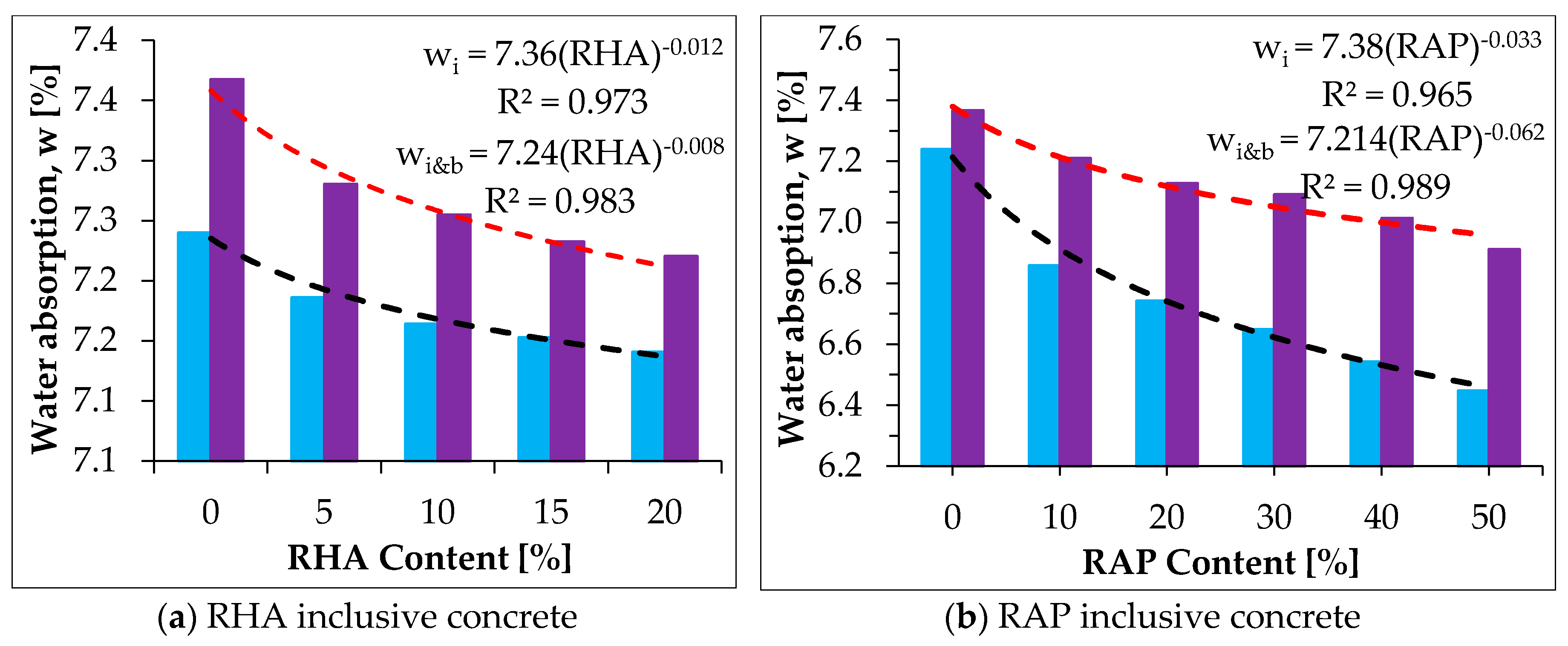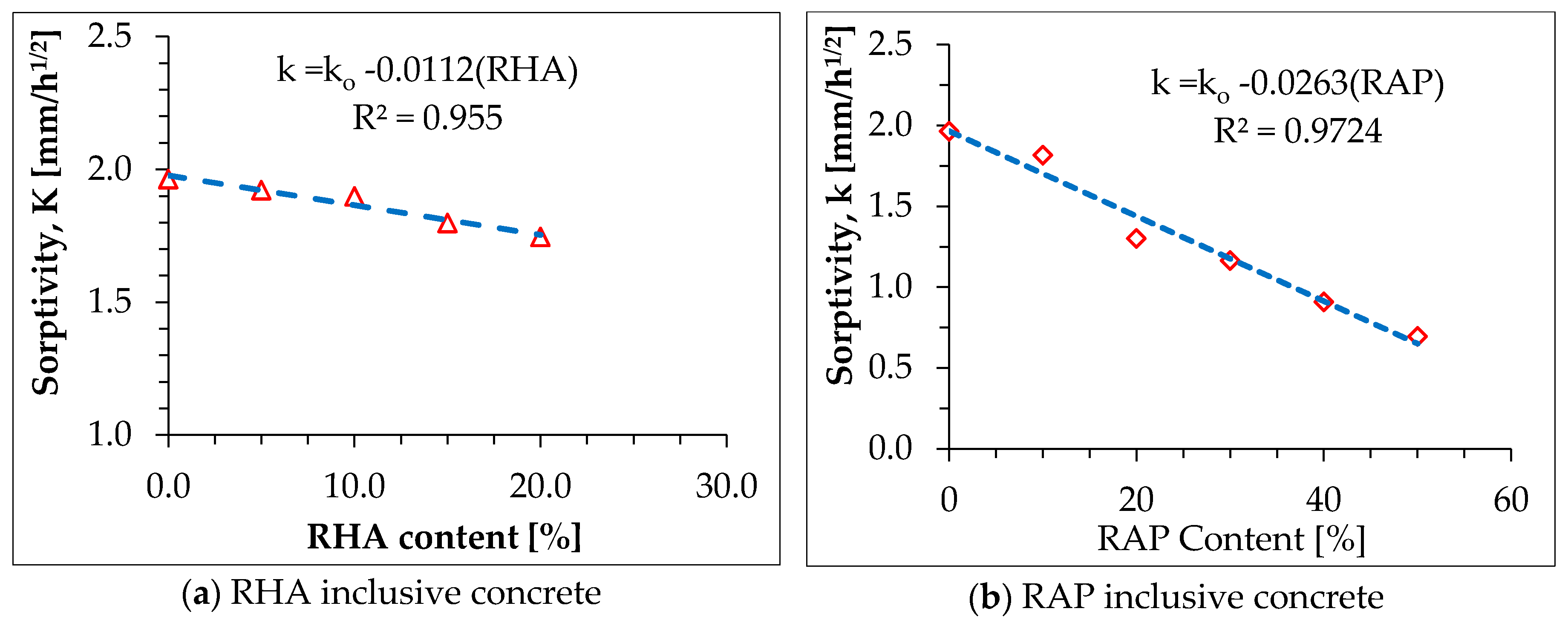3.2.1. Fresh Properties of Concrete
• Slump
From trial mixes, it was observed that RHA caused a dramatic decrease in slump as compared to the control mix. When Sikament NNG SP was added, the slump increased by 23.33% from 60 to 74 mm at 5% RHA and 0.5% SP content. Surprisingly, it was also discovered that as the content of RHA increased, the slump decreased considerably despite increasing the dosages of SP. The slump decreased by 20, 33.33, and 75% from 60 mm to 48, 40, and 15 mm at 10, 15, and 20% RHA content with the addition of 0.85, 2, and 2.75% SP respectively. The high demand for water and the resulted lower slump might be attributed to the large specific surface area and high unburnt carbon content of RHA.
Like that of RHA, the partial replacement of virgin aggregate by RAP resulted in a substantial decrease of slump as compared to the control mix. The slump decreased by 33, 47, 62, 67, and 78% from 60 mm to 40, 32, 23, 20, and 13 mm at 10, 20, 30, 40, and 50% RAP content respectively. The reduction in slump might be attributed to absorption of the mixing water by the fine dust layers around the RAP periphery and water might also be controlled by RAP particle and was not able to move freely and thus, play no role to workability.
The inclusion of both RHA and RAP in the mix found to decrease the slump significantly as expected. However, there was a slight (3%) improvement in the slump when 0.5% Sika ViscoCrete 3088 SP was added to the concrete mix containing (5RHA + 10RAP) % as shown in
Table 8. The slump decreased steadily as the RHA and RAP content increased regardless of increasing the SP dosages. This may be attributed to the combined effects of RHA and RAP as already discussed.
• Compaction Factor (CF)
The CF values of the concrete ranged from 0.758 to 0.953 as shown in
Table 6,
Table 7 and
Table 8; these values are within the ranges specified in BS 1881-103 [
49]. The CF of RHA-inclusive concrete increased by 1% at 5% RHA content, whereas CF decreased by 19% as the RHA content increased to 20%.
Figure 4a and Equation (1) (obtained by regression) show the relationship between slump and compaction factor. R
2 and standard error of estimate (SEE) of the model were 0.958 and 0.012 respectively.
Similarly, the CF values of RAP-inclusive concrete decreased by 5% from 0.935 to 0.892 at 50% RAP content relative to the control mix.
Figure 4b and Equation (2) (obtained by regression) illustrate the relationship between slump and compaction factor. R
2 and SEE of the model were 0.965 and 0.002 respectively.
where:
Cf is compacting factor; and
S is the slump in mm for fresh RHA concrete
where:
Cf is the compacting factor; and
S is the slump in mm for fresh RAP concrete
A slight increase was observed in CF values at 5% RHA + (10–30)% RAP content, whereas CF decreased marginally for the remaining mixes.
Figure 5 (obtained by regression) depicts the relationship between slump and compaction factor for RHA- and RAP-inclusive concrete. R
2 and SEE of the model were 0.894 and 0.013 respectively.
• Fresh Density
The fresh density of RHA-inclusive PCC decreased by 3.8% from 2480 to 2386 kg/m
3 as the RHA content in the mix increased from 0 to 20%. The reduction in fresh density might be due to the fact that the particle density of RHA (2.03) was lower than that of cement particle density (3.12). The relationship between fresh density and RHA content (obtained by regression) is depicted in
Figure 6a. R
2 and SEE of the model were 0.990 and 0.008 respectively.
The mix containing RAP exhibited relatively lower fresh density compared to the mix containing virgin aggregates. The fresh density of RAP-inclusive mix decreased by 5.7% from 2480 to 2339 kg/m
3 as the RAP content in the mix increased from 0 to 50%. The reduction in density might be attributed to the fact that specific gravities of both FRAP and CRAP were lower than those of both FVA and CVA respectively.
Figure 6b (obtained by regression) gives the relationship between fresh density and RAP Content. R
2 and SEE of the model were 0.993 and 0.005 respectively.
The fresh density for mixes containing both RHA and RAP is graphically depicted in
Figure 7. It was observed that the mixes containing both RHA and RAP had lower fresh density compared to the control mix. The mix incorporating 20% RHA + 30% RAP showed 3.6% reduction in fresh density relative to that of the control mix. The reduction in fresh density might be attributed to the collective effects pertaining to RHA and RAP as has been explained.
3.2.2. Hardened Properties of Concrete
Table 9 shows the compressive strength (CS), tensile splitting strength (TSS), bulk dry density, water absorption (w), permeable void spaces (v), and sorptivity (k) of the concrete.
• Compressive Strength (CS)
CS test results of PCC mixtures containing RHA are depicted in
Figure 8a. RHA enhanced the 7-days CS by 12.0, 16.1, 22.4, and 20.5% at 5, 10, 15, and 20% RHA content respectively relative to the control mix. Similarly, the 28-days CS was also enhanced by 4.4, 10.8, 12.5, and 9.0%. In this study, the highest 7 and 28-days CS gain was observed at 15% RHA content.
The 7 and 28 days CS test results of RAP inclusive concrete are depicted in
Figure 8b. A dramatic reduction in CS was observed with an increment of RAP content in the concrete mixtures. The 7 and 28-days CS decreased by 36.1 and 44.3%, relative to the control mix, respectively, at 50% RAP content. This is consistent with the results found in previous studies [
23,
28,
29]. The reduction in CS might be attributed to the collective effect of higher porosity and asphalt cohesion failure, which occurs instead of the adhesive failure of the cement-asphalt interface or cohesive failure of the ITZ [
26,
27].
The relationship between RHA content and the 28-days CS given in
Figure 9a (obtained by regression). The regression model had R
2 and SEE values of 0.950 and 0.444 respectively. The CS decreased linearly with RAP content as shown in
Figure 9b. A similar trend was found by previous study [
61]. From the regression analysis, linear form relationship, Equation (3) was found. R
2 and SEE values of the model were 0.902 and 1.476 respectively.
where:
is the 28-days CS of the RAP-inclusive concrete in MPa;
is the 28-days CS of the mix with no RAP content in MPa; and RAP is the reclaimed asphalt pavement content in %.
Figure 10 portrays the compressive strength of both RHA- and RAP-inclusive concrete at 7 and 28-days. The partial replacement of cement by RHA improved the CS of RAP-inclusive concrete moderately. This might be credited to the development of additional C-S-H gel due to the high reactive silica content of RHA and/or filler effect. Mixtures incorporating (10RHA + 10RAP)%, (15RHA + 10RAP)%, (15RHA + 20RAP)% and (20RHA + 10RAP)% showed comparable strength. The maximum strength (27.62 MPa) obtained at 15% RHA and 10% RAP combination. Thus, it is evident that treatment of RAP by RHA possibly will be an effective way to enhance the mechanical properties of RAP incorporating concrete.
• Tensile Splitting Strength (TSS)
The 28-days TSS of the mixtures containing RHA is represented in
Figure 11a. There was a gradual increment in TSS with increasing the RHA content up to 15%. The TSS peaked at 15% RHA and then decreased beyond 15% RHA. However, still 20% RHA inclusive concrete showed better strength than the control mix. The increment in strength was 2.8, 6.1, 7.5, and 5.6% at 5, 10, 15, and 20% RHA content respectively, relative to the control mix. TSS increased in a second-order polynomial with RHA content as depicted in
Figure 11a (R
2 = 0.96 and SEE = 0.018). The trend for TSS was similar to that of CS. The increment in TSS might be ascribed to the development extra of C-S-H gel due to the active silica content of RHA.
TSS decreased linearly with increasing the RAP content as can be seen in
Figure 11b (R
2 = 0.98 and SEE = 0.052). TSS decreased by 12.2, 20.7, 29.6, 34.7, and 40.8% for 10, 20, 30, 40, and 50% RAP respectively. The decrement pattern for TSS was similar to that of the CS. However, the rate of strength reduction in the TSS mixtures was lower compared to the CS’s. This is consistent with previous study [
26].
From regression analysis, a power form relationship was found between the 28 days TSS and CS of RHA inclusive concrete as shown in Equation (4) and
Figure 12a (R
2 =0.99 and SEE= 0.004).
where:
and
fct are the 28-days CS and TSS of the RHA inclusive concrete respectively, in MPa.
The exponential form relationship was found between the 28 days TSS and CS of RAP inclusive concrete as presented in
Figure 12b (R
2 = 0.97 and SEE = 0.0526). Equations (5) and (6) were obtained by regression.
where:
and
are the 28-days CS and TSS of the RAP inclusive concrete respectively, in MPa.
The experimental results of TSS of both RHA and RAP inclusive PCC and its relationship with CS are depicted in
Figure 13 and
Figure 14 respectively. TSS was improved by 4.7% at 15% RHA and 10% RAP content compared to the control specimen’s result which was similar to the CS results. TSS and CS were positively correlated (R
2 = 0.928 and SEE = 0.065) with a power function as shown in Equation (7).
• Water Absorption
The water absorption after immersion (w
i) and after immersion and boiling (w
i&b) decreased with increasing RHA content as shown in
Figure 15a. The minimum relative percentage of reduction in water absorptions were 0.7 and 1.2% for w
i and w
i&b respectively at 5% RHA content, whereas the maximum relative percentage of reduction in water absorption were 1.3, and 2.0% for w
i, and w
i&b respectively at 20% RHA content. This reduction could be due to the fact that the finer HHA particles might have filled the pore spaces of the concrete. The water absorption is correlated to RHA content in a power function as shown in Equations (8) and (9). The w
i&b values are slightly higher than those of w
i.
The water absorption of RAP inclusive concrete decreased with increasing RAP content, as can be seen from
Figure 15b. The minimum w
i and w
i&b were 6.4, and 6.9%, with relative percentage reduction of 10.94 and 6.20% respectively at 50% RAP content. The reductions in water absorption might be due to the lower water absorption of RAP aggregates compared to that of virgin aggregate. The other possible reason might be due to the melted asphalt and dust layer engulfed around the aggregate could fill void spaces in the concrete [
62]. The water absorption is related to RAP content in a power function as shown in Equations (10) and (11). The w
i&b values were somewhat higher than those of w
i.
where:
is the water absorption after immersion in %; w
i&b is the water absorption after immersion and boiling; RHA and is the rice husk ash content in %; and RAP is reclaimed asphalt pavement content in %.
The water absorption of RHA and RAP inclusive concrete at 28 days are depicted in
Figure 16. Both
and w
i&b decreased as RHA and RAP content increased. The relative percentage reduction of w
i&b (13.7%) was lower than both that of RHA inclusive concrete (1.30%) and RAP inclusive concrete (10.94%). The least w
i, and w
i&b found were 6.25, and 7.06% respectively at 20% RHA and 30% RAP combination. The maximum relative percentage of reduction in absorption were 13.7 and 4.2% for the respective least absorptions. The reduction of water absorption might be due to the collective effect of RHA and RAP discussed above.
• Volume of Permeable Void Spaces in Hardened Concrete
The volume of permeable void spaces in hardened RHA inclusive concrete decreased slightly with increment of RHA. The voids decreased by 3.22% from 17.32 to 16.77% as the RHA content increased from 0 to 20%. The reduction in void space might be attributed to the finer siliceous particles which could fill a portion of void spaces that exist in the concrete matrix. As can be seen from
Figure 17a and Equation (12), a power function was found as a good fit (R
2 = 0.970 and SEE = 0.026) to correlate RHA content with the voids.
Figure 17b depicts the volume of permeable void spaces in RAP inclusive concrete. It is clear from the figure that voids decreased exponentially with an increment of RAP content. The voids decreased by 9.47% from 17.32 to 15.68% as the RAP content increased from 0 to 50%. The reduction in void space could be due to the lower water absorption of RAP aggregates compared to that of virgin aggregates and oozed out asphalt film which could fill a portion of voids spaces in concrete. As can be seen from Equation (13), an exponential function was obtained from regression analysis to correlate RAP content with the voids (R
2 = 0.995 and SEE = 0.024).
where:
is the volume of permeable void spaces in %; and RHA is the rice husk ash content in %; and RAP is the reclaimed asphalt pavement content in %.
A relationship between voids and water absorption for RHA concrete was determined as shown in
Figure 18a and Equations (14) and (15). According to the correlation found, water absorption decreased exponentially as the void in concrete decreased. Water absorption by RAP concrete decreased exponentially with voids in concrete as shown in
Figure 18b, and Equations (16) and (17).
where:
is absorption after immersion in %; w
i&b is absorption after immersion and boiling; and
v is the volume of permeable void spaces in %.
The volume of permeable void spaces in both RHA and RAP inclusive PCC is portrayed in
Figure 19. As expected, the relative percentage of reduction of voids (4.86%) in both RHA and RAP inclusive PCC is higher than that of RHA inclusive PCC (3.22%) but lower than that of RAP inclusive PCC (9.47) by 1.64 and 4.61% respectively.
• Sorptivity
The sorptivity by RHA concrete, shown in
Table 10, was obtained from the slope of the line that is the best fit to the cumulative amount of water absorption (I) plotted against the square root of time (t
1/2), depicted in
Figure A1 and
Figure A2 shows the cumulative amount of water absorption from which the sorptivity of RAP inclusive concrete was determined and tabulated in
Table 11.
The effect of RHA content on the sorptivity of concrete is depicted in
Figure 20a. As can be seen from Equation (18), the sorptivity decreased linearly as the RHA content increased. The sorptivity decreased by 11.1% from 1.964 to 1.746 mm/h
1/2 when RHA content increased from 0 to 20%. The reduction in sorptivity might be due to the fact that finer RHA particles filled up air voids exist in the concrete matrix, as a result of which the rate of ingress of water was inhibited. The influence of RAP content on the sorptivity of concrete is also portrayed in
Figure 20b. Sorptivity decreased significantly as the content of RAP increased. A linear relationship was found between RAP content and sorptivity, and Equation (19) represents the same. Similar findings were reported in the previous studies [
13,
27]. The main reason being given for the reduction in sorptivity was the melted asphalt layer surrounding the RAP aggregates. In addition, the authors of this paper believed that the reduction in sorptivity might also be ascribed to the lower water absorption by the RAP aggregates compared to that of the virgin aggregates.
where:
k and
ko are the sorptivity by RHA inclusive concrete and concrete without RHA respectively in mm/h
1/2; and RHA is the rice husk ash content in %.
where:
k and
ko are the sorptivity by RAP inclusive concrete and concrete without RAP, respectively, in mm/h
1/2; and RAP is the reclaimed asphalt pavement content, in %.
Figure A3,
Figure A4,
Figure A5 and
Figure A6 depict the cumulative amount of water absorption (I) plotted against the square root of time (t
1/2), from which the sorptivity by both RHA and RAP inclusive concrete was determined and tabulated in
Table 12.
It is evident from experimental results that the sorptivity by RHA and RAP inclusive concrete was decreased as expected. The reduction in sorptivity ranged from 2.29 to 28.16% relative to the control specimens. The reduction in sorptivity could be due to the combined influences of RHA and RAP as already discussed.
Although sorptivity value alone does not suffice to envisage the service life of a structure [
63], according to the research conducted by Hinczak, Conroy, and Lewis, cited in the study [
64], a concrete is said to be durable if sorptivity is less than 6 mm/h
1/2. The experimental results of this study revealed that all concrete specimens had sorptivity values under the limit specified i.e., considered as durable concrete holding other factors constant.







